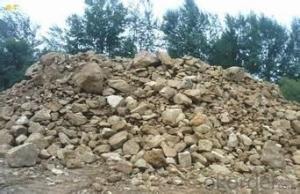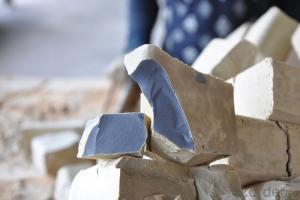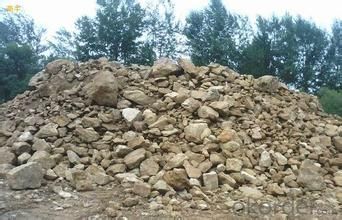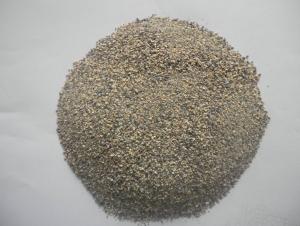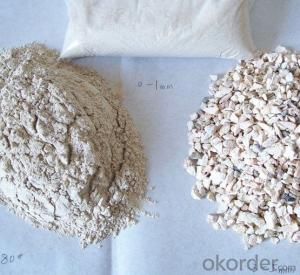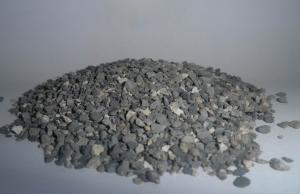Raw Materials for Refractory:High Quality Bauxite Alumina Refractory Aggregate of CNBM in China
- Loading Port:
- Tianjin
- Payment Terms:
- TT OR LC
- Min Order Qty:
- 11 m.t.
- Supply Capability:
- 10000000 m.t./month
OKorder Service Pledge
OKorder Financial Service
You Might Also Like
High Quality Bauxite Alumina Refractory Aggregate of CNBM in China
1.Structure of Calcined Bauxite Description
Bauxite (aluminous soil; Bauxite) is also called the alumina or bauxite, main ingredients are alumina, hydrated alumina containing impurities, is an earthy mineral. White or gray, brown and yellow or light red by iron. From 4 to 3.9 g/cm3 density, hardness, 1 ~ 3 is not transparent, very brittle. Very difficult to melt. Insoluble in water, soluble in sulfuric acid, sodium hydroxide solution. Mainly used for aluminium, refractory material.
2.Main Features of the Calcined Bauxite
Calcined bauxite is one of the principal ore of aluminum. Calcined bauxite contains hydrous aluminum oxides and aluminum
hydroxides, formed through the laterization of aluminous rocks in tropical and subtropical areas .Calcined bauxite is obtained by calcining (heating)superior grade bauxite at high temperature (from 85OC to 1600C) .This removes moisture there. By increasing the alumina content,compared to an alumina content of about 57%to 58% in raw bauxite, calcined bauxite has an alumina content of 84%to88%.The heating is carried out in rotary kilns.
3.Main usage of the Calcined Bauxite
1, Aluminium metallurgy
2, Precision casting/Investment casting,
bauxite grog fines can be made into mold for precision casting.
3, Refractory, High alumina bauxite's refractoryiness can reach 1780oC. It is charactered by good chemical stability and mechanical performance.
4, Aluminium silicate refractory fiber, The high alumina bauxite grog can melt under 2000oC to 2200oC in the electric arc furnace.After a series of processing, it can become aluminium silicate refractory fiber, which can be made into fiber blanket, cloth, plate and so on
5, Mixing magnesia and bauxite grog with binders to pour the molten steel ladle for better overall lining performance.
6,Producing bauxite cement
7,Abrasives
8, Ceramics industry
9, Chemistry industry for all kinds of aluminium compound.
4. Calcined Bauxite Images


5. Calcined Bauxite Specification
| Place of Origin: | Jiangsu, China (Mainland) | Shape: | Powder | Material: | Diatomite |
| SiO2 Content (%): | 25%~65% | Al2O3 Content (%): | 30%~70% | MgO Content (%): | 0.22% |
| CaO Content (%): | 0.28% | Refractoriness (Degree): | 1770°< Refractoriness< 2000° | CrO Content (%): | 0.01% |
| SiC Content (%): | 0.01% | Brand Name: | CNBM | Colour: | Brown/Grey/White |
6.FAQ of Calcined Bauxite
1). Q: Are you a factory or trading company?
A: We are a factory.
2). Q: Where is your factory located? How can I visit there?
A: Our factory is located in ShanXi, HeNan, China. You are warmly welcomed to visit us!
3). Q: How can I get some samples?
A: Please connect me for samples
4). Q: Can the price be cheaper?
A: Of course, you will be offered a good discount for big amount.
- Q: How many kinds of refractory materials are there in the EI?
- I suggest that you contribute articles to foreign SCI journals for the odds are better, and generally the articles that fill the bill will not be rejected. The traditional refractory materials can contribute to EI journal. If being rejected by EI journal, you can also contribute to Russia's journal Industrial Ceramics and Refractories. I didn't contribute to the Journal of Wuhan University of Science and Technology, the receiving cycle is almost 3 to 4 months. Though the impact factor is low, domestic EI journal is not so good, it is still SCI journal. This is my own experience, please take my advice. The best journals are the Journal of the American Ceramic Society and the Journal of the European Ceramic Society, I heard that they are not bad. But the best domestic EI refractory material journal is the Journal of The Chinese Ceramic Society. It is very long, but if it belongs to your university, it is another pair of shoes. Journals now all want to have materials about functional ceramics, and they don't want Chinese articles, if your English is not well enough, you can choose Ceramics International and Japan Ceramics but they have strict manuscripts reviewing standards.
- Q: How can refractory materials be divided?
- There are many criteria for the classification of refractories.Just referring to a book about refractory.
- Q: Who knows what is the external wall thermal insulation materials for level A fireproofing?
- external wall thermal insulation materials level A fireproofing: Incombustible building material is a material that does not occur any burning. Class A1: Monomer inorganic non-combustible. Noncombustible means no open fire. Class A2: Non-flammable organic compound is namely composite materials and non-flammable, the amount of smoke must be qualified. Class B1: nonflammable building material: non-flame material has good flame resistance. It is difficult to fire under the condition of open fire in the air or high temperature, and it is not easy to quickly spread, and when the combustion?source is removed, the combustion will stop immediately. Class B2: combustible?building?materials: flame material has a good flame resistance. In case of fire in the air or at high temperature, it will immediately burst into flames, and easily lead to the spread of fire, such as wooden column, timber roof truss, timber beam and wooden stairs.
- Q: what's the fireproof levels of fireproof and thermal inuslation matertial?
- What are the fireproof levels of fireproof and thermal inuslation matertial on the market? how to divide the fireproof levels of fireproof and thermal insulation material?
- Q: What a blast furnace refractories generally?
- refractories for blast furnace include carbon brick and silicon-aluminum refractory. BF carbon brick inlcudes half-carbon charcoal bricks, microporous charcoal brick, ultra porous charcoal bricks, graphitic brick and mould pressing charcoal brick. tiles and molded graphite small charcoal bricks. I hope my answers above are helpful to you and your ideal anwers.
- Q: How long is the fire endurance of the rock wool board?
- Hello. The limit is up to 2 hours. Of course such a thing is not desirable.
- Q: What do refractory materials include?
- It is so difficult.
- Q: What is the interior fireproof thermal insulation material?
- polystyrene foam board, glass fiber spraying, polyurethane foam, thermal insulation system of inorganic wall. Use "DY" inorganic active thermal insulation material, have small thermal conductivity, large heat storage coefficient, better strength and achieve better thermal insulation and energy-saving effect when used in wall . Wall should definitely not crack and hollow because of high temperature in summer. It doesn't crack and shed because it is influenced by stress during heat expansion and cold contraction in cold winter.
- Q: What are the types of advanced refractory?
- it can be divided into two categories of general and special refractories ordinary refractories by chemical properties into acidic, neutral and alkaline. Special refractory composition divided by high temperature oxide, refractory compounds and high-temperature composite materials Furthermore, according to refractoriness can be divided into ordinary refractory products (1580 ~ 1770 ℃), advanced refractory products (1770 ~ 2000 ℃) and grade refractory products (2000 ℃ above). the article can be divided into blocks (standard bricks, shaped bricks, etc. ), special shape (crucible, sagger, pipe, etc.), fibrous (aluminosilicate, zirconia and boron quality, etc.) and a random shape (refractory clay, pouring materials and ramming mixes, etc.) according to the sintering process it can be divided into sintered products, cast products, melt blown products.
- Q: Who knows about the B-level fireproof insulation materials?
- Commonly used B-level materials: Molding polystyrene foam, extruded polystyrene board, gelatine powder polyphenyl granule heat insulating slurry. Although the polyurethane is not the commonly used material, but the 9mm composite of monolayer gypsum board and PU insulating material can reach B-level.
Send your message to us
Raw Materials for Refractory:High Quality Bauxite Alumina Refractory Aggregate of CNBM in China
- Loading Port:
- Tianjin
- Payment Terms:
- TT OR LC
- Min Order Qty:
- 11 m.t.
- Supply Capability:
- 10000000 m.t./month
OKorder Service Pledge
OKorder Financial Service
Similar products
Hot products
Hot Searches
Related keywords
